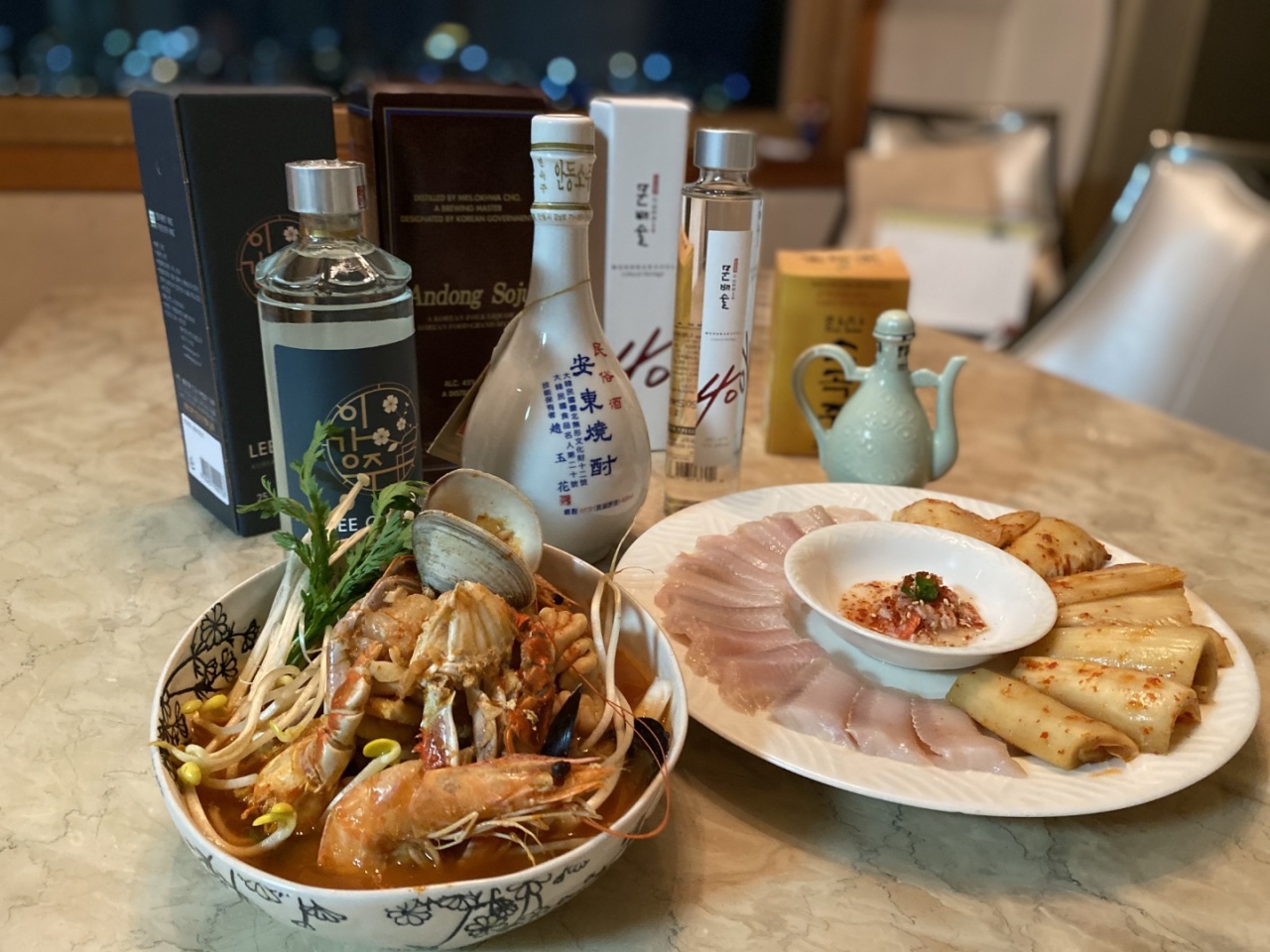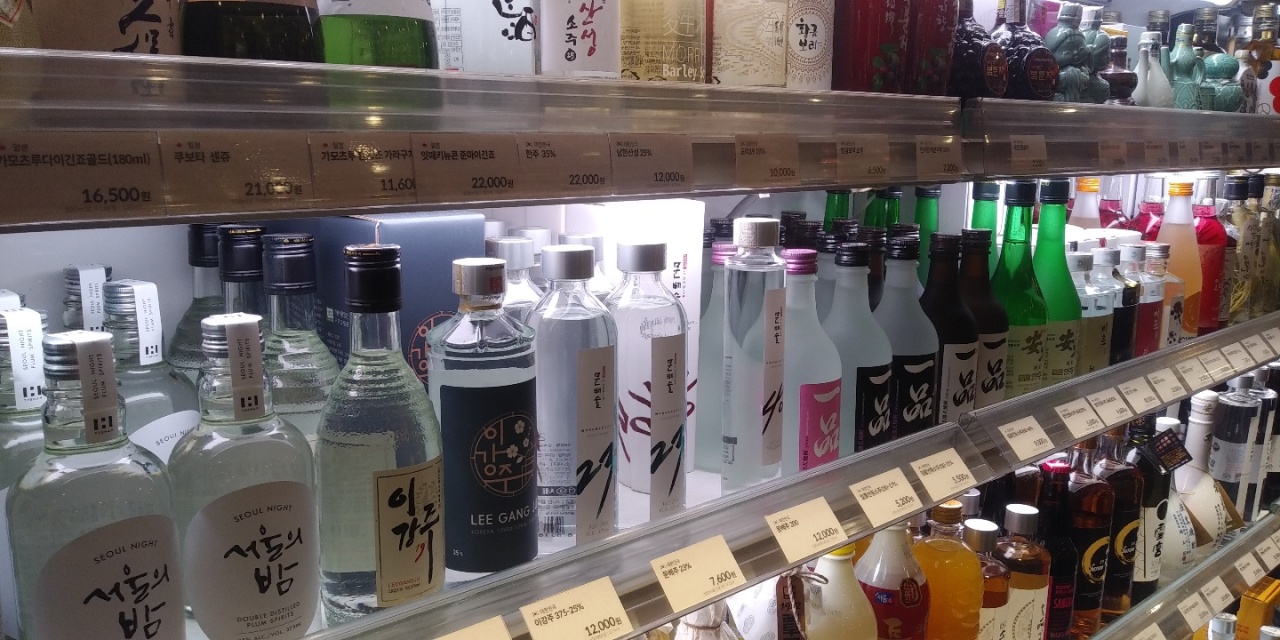 |
Four of the most well-known distilled soju products are displayed. (Ko Jun-tae/The Korea Herald) |
Drinking in South Korea almost invariably involves soju. The ubiquitous green bottle filled with watered-down alcohol has been, and is, at center stage of Seoul’s drinking scene.
The soju most people usually think of -- a mixture of water, alcohol and sweeteners -- is very much an integral part of Korea’s social fabric, and accounts for close to 40 percent of all alcohol consumed in Korea.
But while it may be an iconic feature of Korean drinking, many say its taste doesn’t live up to its name value.
“To me, soju is like watered-down vodka, but it has that weird, disgusting aftertaste,” said Kim Jung-tae, a 31-year-old salesperson based in Mapo-gu, western Seoul, whose job often consists of drinking with clients after regular work hours.
“I only drink soju because others do, and I would not order this stuff on my own. There are many, many other options I can take to not risk throwing up from disgust.”
Responding to the demands of people like Kim, an increasing number of distilleries and businesses are presenting the traditional, original type of soju.
The traditional distilled spirit goes back as far as the Goryeo Kingdom in the 13th-century. It is made by distilling alcohol from fermented grains, including rice, sweet potato or tapioca, and many producers today have put their own spin on it by adding ingredients for better taste or scent.
“More and more people are looking to actually enjoy alcohol rather than using it as a means to get wasted, and traditional Korean liquor, including distilled soju, is what they opt for,” said Myung Wook, a traditional Korean liquor expert and a visiting professor at Sookmyung Women’s University, adding that demand for traditional liquor has been on the rise.
The traditional soju is often pricier than the one as we know of but is presented with an array of different scents and tastes not found in its more ubiquitous cousin. And that is why soju aficionados and a growing number of consumers looking to appreciate alcohol are opting to spend more for quality.
Regular diluted soju is priced at around $2 a bottle, but the price tag for a bottle of the distilled spirit can go up as high as hundreds of dollars.
“People buying distilled soju are not looking to finish a bottle in one sitting,” according to Myung. “They are rather looking to stock it on the shelf and enjoy a shot or two every now and then, on the rocks, straight or cocktail, however the way it is.”
 |
Traditional Korean liquor products are displayed for sale inside the Lotte Department Store in Jung-gu, central Seoul. (Ko Jun-tae/The Korea Herald) |
Andong soju, probably one of the most well-known for its unique scent of yeast and smoothness, has been at the forefront of the distilled soju market and has served as one of the most famous specialties from North Gyeongsang Province.
Its rival Munbaeju, that originates in Pyongyang, attracts consumers with a distinctly fruity scent of wild pear and runs smoothly down the throat. The drink was served as an official drink at the South Korea-Soviet Union summit in 1991 and the ceremonial party for former President Roh Tae-woo’s visit to the United Nations the same year.
Leegangju from Jeonju, North Jeolla Province, makes itself known with a kick of cinnamon and resembles the taste of sujeonggwa, a traditional Korean persimmon punch. The drink brings in a sense of comfort as if sitting inside a grandparent’s house.
Hansan sogokju, nicknamed the “sit-down drink” because it entices people to desire one sip after another, emanates waves of floral fragrance and covers the taste buds with sweetness. The traditional spirit hails from South Chungcheong Province, and has won a number of awards locally and internationally.
And with such unique distilled soju products becoming more qidely available, the market has grown and is expected to keep growing in coming years. Data from the National Tax Service shows the number of licensed distilled soju manufacturers surged from 51 businesses in 2012 to 92 in 2018.
But in order for it to better appeal to the market and gain ground, experts say much more promotional effort is needed to inform regular consumers of the variety and uniqueness of Korean traditional liquor, including distilled soju, which will help raise domestic and overseas sales.
The government has lifted some regulations and offered financial support to traditional Korean liquor manufacturers, but that alone are not enough to put the industry shoulder to shoulder alongside western drinks like whiskey, vodka and wine, they say.
Regulatory relief in 2017 has allowed all types of traditional Korean liquor to be sold in online channels, and paved the way for more businesses to jump into the competition for distilled soju and other types of traditional liquor.
“It is necessary to revise the scope of traditional liquor to include all products recognized as traditional types by regular consumers, and this will help our products better compete against beer, wine, baijiu and whiskey,” said Yum Sung-kwan, head researcher at makgeolli manufacturer Seoul Jangsoo in a report last year.
“And at the same time, the industry also needs to make their own efforts, not rely too much on help from the government, in order to gain competitiveness enough to stay independent in the global market.”
For traditional Korean liquor to thrive in the global market, experts are also calling on government-led agencies to step up and assist globalization of locally made drinks. Branding and marketing are essential for Korean liquor to expand its presence in the global market, they argue.
“State-run agencies should help local drinks to expand overseas and raise their value by commercializing our cultural items through storytelling, like combining our traditional liquor with Korean food,” Shin Dong-ho, a public administration professor at Hannam University, wrote in a report last year.
“Local distilleries should also creatively consider their geographical characteristics to partner up with local governments and form brewing industry clusters on regional scales, which will show progress from early on.”
By Ko Jun-tae (
ko.juntae@heraldcorp.com)









